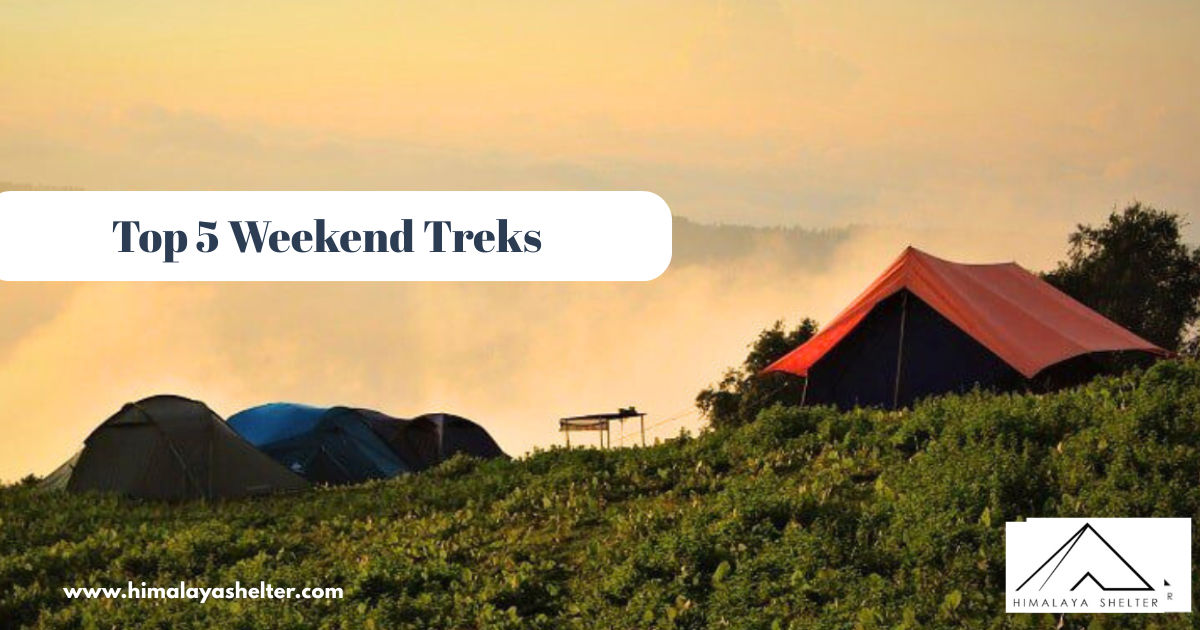
The Benog Hill Trek
TREK DIFFICULTY
Moderate
TREK DURATION
2 Days
HIGHEST ALTITUDE
7270 Feet
GROUP SIZE
12
TREK DISTANCE
8 Km
BASECAMP
Uttarakhand
BEST TIME
All year except monsoon
PICKUP POINT
Dehradun (Prince Chowk)
The Benog Hill Trek Overview
Benog Hill is a day trek starting from Mussoorie, the queen of hills . A perfect trail for nature lovers in the Mussoorie Wildlife sanctuary. This sanctuary was established in 1993 and is home to the nearly extinct Mountain Quail. The lush green forests, the birds, a variety of flaura and fauna, and if we are lucky we can spot deers, mountain goats, flying squirrels and mountain quails. All of this makes it a very memorable trek from Dehradun, Delhi, Chandigarh and other nearby cities.
Benog Hill trek usually starts from Cloud’s End, located at the western edge of Mussoorie and leads into the dense forests of oak and pine. The trail is around 3 to 4 km one way and typically takes 3-4 hrs for a round trip.
Benog Hill is known for its rich biodiversity. It is a paradise for wildlife enthusiasts and nature lovers. Also, the breathtaking views from the summit, makes this trek memorable. On a clear day, you can spot the snow-capped peaks of Bandarpoonch and Chaukhamba. On top of that, the ancient Jwala Devi Temple, located on the hilltop, adds spiritual treasure to the trekking journey.
Overall, the Benog Hill trek is a short and pleasant trek which you can enjoy with your families and loved ones without making too much preparations. Except for the heavy monsoon and peak winter, it can be done all year. Its easy-breezy and tranquil vibes take your worries away and make you feel refreshed than ever.

Day 1 – Dehradun → Benog Tibba Basecamp
Morning (around 6:30 AM): Pickup from Prince Chowk, Dehradun → Clouds End, Mussoorie (approx. 2 h drive, 35 km)
Day 2 – Benog Tibba → Dehradun
Morning: Trek 200 m to trail exit near sanctuary gate → followed by 2 h drive (36 km) back to Dehradun (drive starts 10:30 AM)
In Himalaya Shelter, we provide you with the option to customize your Benog Hill trekking experience. Whether you're a beginner, solo traveller or a group of friends, you can opt for our personalized tailor-made trekking program. This customized trek will be exclusively designed for you, taking into account your specific requirements for transportation, accommodation, meals and any other premium facilities you may need during the trek.
Starting from Mussoorie (pick up point), the Benog Hill trek's trail passes through oak, pine, rhododendron forests and Benog Wildlife Sanctuary. It ends near Jwala Devi Temple. Himalaya Shelter ensures your journey is safe and memorable with experienced local guides and all necessary permits. You can even request offbeat routes or sunrise hikes for a more immersive Himalayan experience.
Moreover, no other participants will be added to your group. Choosing a customized trek will enable you to fully enjoy the trek with your loved ones.
Benog Hill holds a deep historical relation. Its surrounding region lies within the Garhwal Himalayas which was the part of Katyuri Dynasty (7th-11th century CE). It was a remote area but was used for seasonal migration and trade occasionally.
Benog Hill is believed to be the part of Trijuginarayan Temple region. As per locals, from ancient times, probably during Mahabharata time, the region was known as a meditation spot. Many sages and ascetics meditated here in the caves and dense forests of Benog Hill. Still the spiritual frequency of this region is very high.
Benog Hill is also known for Jwala Devi Temple. Jwala Devi is believed to be the incarnation of Goddess Durga. Locals tell stories about how Goddess Durga was manifested as Jwala Devi, born from fire on Benog Hill and defeated demon Jalandhar in a fierce battle. Locals believe that Jwala Devi is also one of the seven sisters (Sapt Jwala) and each one of them protects the a direction. Jwala Devi protects the western Himalayan belt, particularly Mussoorie and its surrounding hills.
During British times, when Mussoorie was developed as a summer retreat and popular hill station, Benog was explored and gained attention for its rich biodiversity. The Benog Wildlife Sanctuary was declared a protected area later and became part of the Rajaji National Park buffer zone. Today it is well known for its hiking culture and eco-tourism. It attracts many tourists across the world.
Benog Wildlife Sanctuary: Benog Hill trek passes through the Benog Wildlife Sanctuary. It is home to rare fauna and flora. You can spot mountain quail (once thought extinct), Himalayan goat, panthers and many species of birds. It is popular for bird watching; you can spot a rich variety of birds here, especially early morning chirping sounds will amaze you. The dense forests of oak, pine, deodar and wildflowers like primulas, violets and asters make it a perfect soul refreshing trail.
View of the Bandarpunch and Chaukhamba Peaks: From the summit, you can spot the snow-capped peaks of Bandarpoonch, Chaukhamba and Swargarohini on clear days. These panoramic views are like visual delight which makes your journey rewarding. For such beautiful sceneries, the Benog Hill trek rivals many popular Himalayan viewpoints, especially in a short hike you have a lot to see.
Sacred Jwala Devi Temple: Benog Hill trek is a spiritual hike also. At its summit, the sacred Jwala Devi Temple lies. It is dedicated to Goddess Durga. Here Goddess Durga is believed to be manifested as a fire. She is believed to be born from fire and devotees believe that fire burns eternally without any fuel. Trekkers often visit this temple and offer their prayers. It is believed to be the place where wishes are granted.
Beginner-friendly Forested Trails: Benog Hill trek is for all age groups. Being a beginners-friendly trek, people can enjoy this trek without being exhausted. The trek has forested trails. The forests of oak, pine, deodar and rhododendron are dense and lush green. Some trees are century old and known for their traditional usage in Ayurveda. Along the forested trails, you will see small caves where hermits and sages have meditated for years. Those who want a mindful walk, Benog Hill trek is perfect for them.
Benog Hill trek is considered an easy to moderate trek which is suitable for beginners, families and kids over 6 years. It is located near Mussoorie at an elevation of approx 2,250 m (7,380 ft).
The trail starts from Cloud’s End or George Everest Estate and goes through the Benog Wildlife Sanctuary. Benog Wildlife Sanctuary is known for its rich biodiversity and you get to see a variety of flora and fauna here. The trail is about 7 to 8 km long (in round trip) and takes 3 to 4 hours to complete, depending on your pace. Most people finish it within a half day.
The trail is well-marked and involves mud paths, forest trails and normal uphill sections. You can encounter few steep patches near the summit but they are not technically challenging. You can hire a guide but they are not mandatory – trails are well-marked and beginner-friendly so no technical and navigation issues arise.
Benog Hill is an all-season trek and weather is mostly pleasant year-round but still avoid monsoon and peak winter. Mornings and evenings are generally cooler, especially in winter. Summer is ideal for clear views and comfortable hiking.
Wear comfortable clothes (trekking pants) and good quality trekking shoes. Carry water and light snacks. Network is hampered in some areas so inform someone before you go. If you're a solo trekker and unfamiliar to routes, hiring a guide is recommended.
For the best and comfortable trekking experience, plan your Benog Hill trek from March to June and September to November. These months offer pleasant weather, scenic trails, clear sky and good visibility of surrounding peaks like Chaukhamba and Bandarpoonch.
March to June (Spring to Summer):
During these months, forests are lush green and vibrant. You will see blooming rhododendrons everywhere which make the journey pleasant and enjoyable. Trails remain mostly dry and safe. Sometimes there can be occasional rain but otherwise, weather remains clear. Daytime temperatures range between 15°C to 25°C. Nights can be chilly around 7°C to 12°C temperatures. Keep a light jacket and raincoat to avoid unpredictable weather conditions.
September to November (Autumn):
After monsoon, air becomes crisp and sky turns clearer. Landscapes are even fresher after rain but by late October they turn golden due to autumn. Sunlight feels cozy and visibility to view Himalayan peaks are very high. This is a good time for birdwatchers and nature lovers as the Benog Wildlife Sanctuary is quite active around this season. Daytime temperature remains around 12°C to 20°C while at night time it dips to 5°C to 10°C. Winter clothes are must for this season.
Avoid Monsoon and Harsh Winters:
July-August (monsoon) should be avoided. Due to heavy rainfall, trails become slippery and leech-infested. Risk of landslides is also high. Similarly, avoid December-February for harsh winters. Temperature is near 0°C and below this time and visibility is very poor.
For trekking to Benog Hill, first reach Mussoorie in Uttarakhand. Mussoorie is well-connected by air, rail and road to major cities of India. The nearest airport is Jolly Grant Airport in Dehradun which is located around 60 km from Mussoorie. From airport you can hire a taxi to reach Mussoorie (around 2 hrs).
By road, Mussoorie is well connected via NH 7 and NH 307. Regular buses, including deluxe and Volvo run from Delhi, Haridwar and Dehradun. Also, for train travelers, Dehradun Railway Station is the closest station, around 35 km away.
Upon reaching Mussoorie, the base point for Benog Hill trek is Clouds End which is located around 6 to 7 km from Library Chowk. You can reach Clouds End by private cab, rented bike or even by trekking through George Everest Estate.
From Clouds End, the trek to Benog Hill passes through dense forests of pine, oak, rhododendron and Benog Wildlife Sanctuary. The trail is approx 4 to 5 km one way and ends near Jwala Devi Temple.
To avoid any inconvenience, start early in the morning. Check forest entry timings as the sanctuary usually closes by late afternoon. Carry water bottles and light snacks.
Physical Fitness Preparation for Trek:
To overcome the difficulty level of trekking, it requires strong cardiovascular endurance, muscular strength, and overall physical fitness. Incorporate these exercises into your routine to increase strength, stability, and stamina, which will help you tackle difficult terrain sections of the trail at high altitudes.
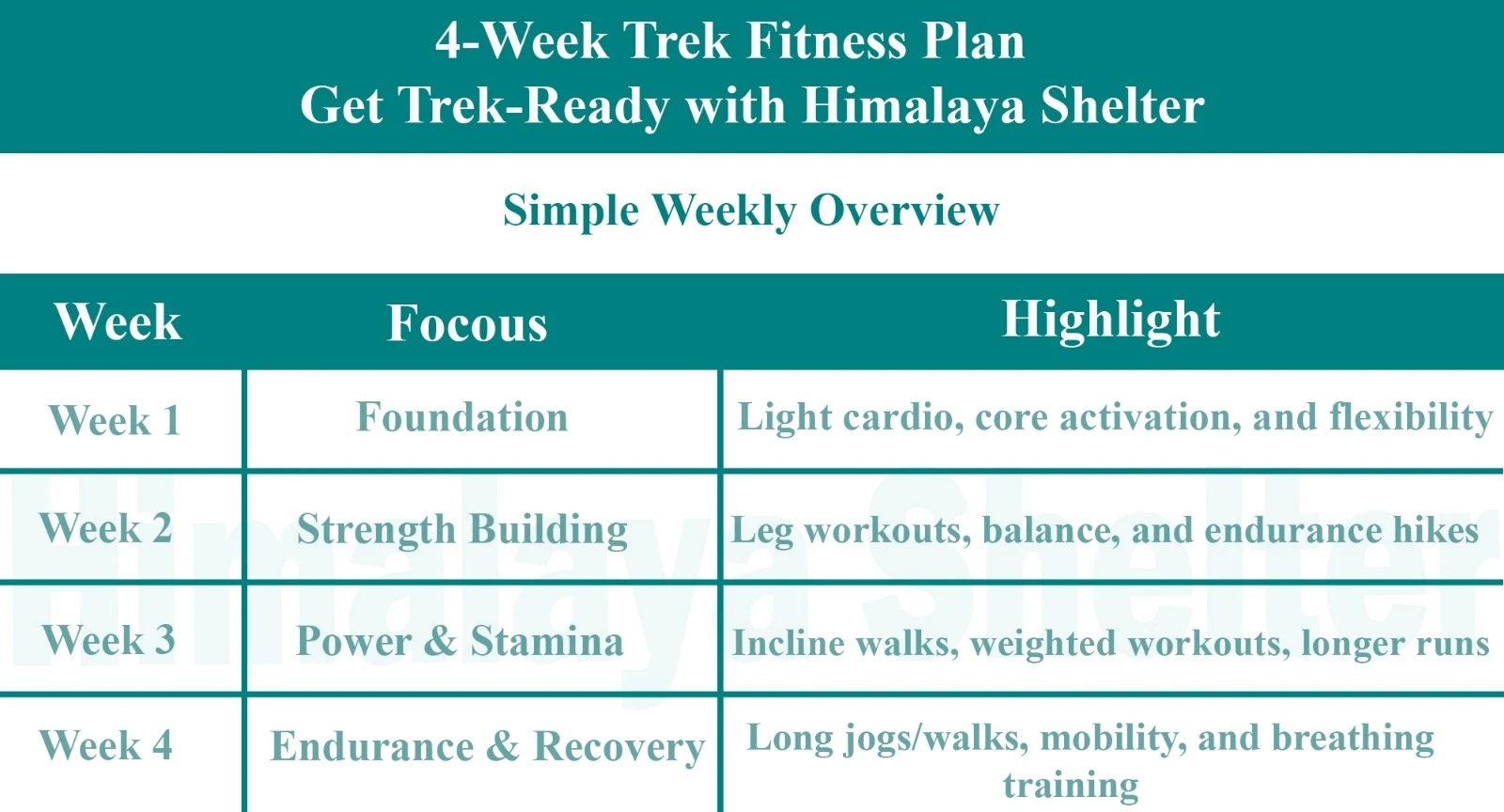
Overview
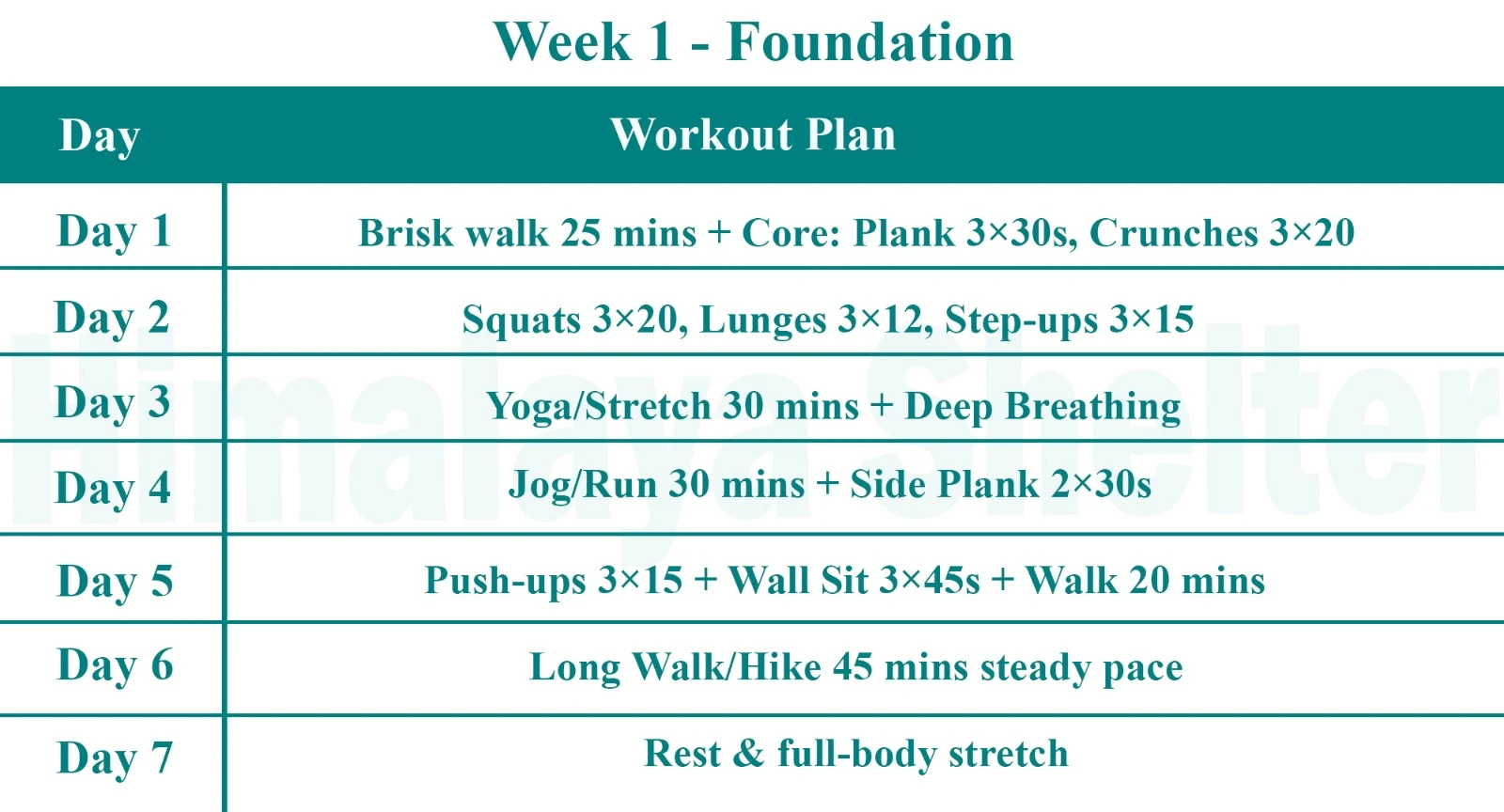
Foundation
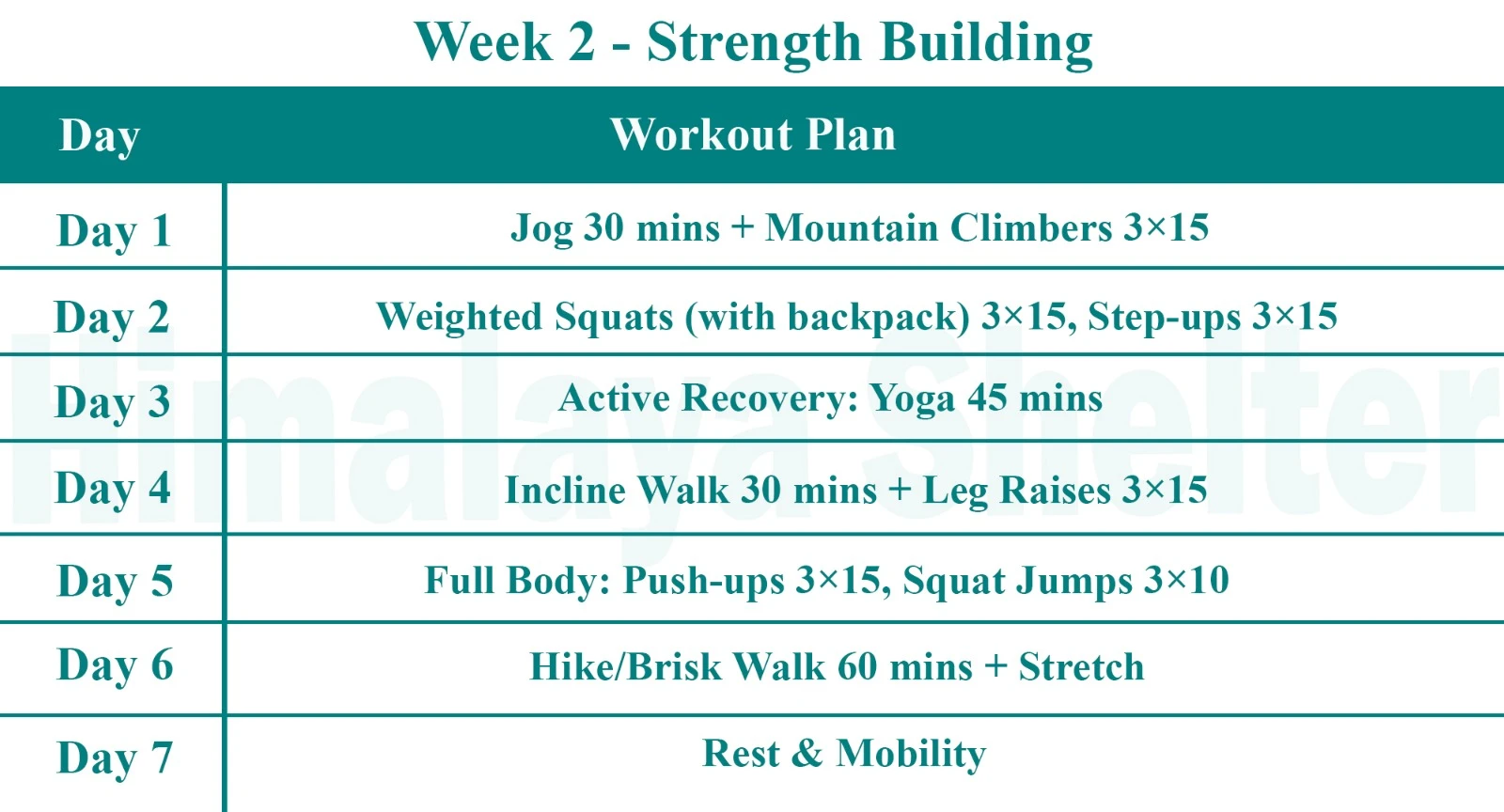
Strength Building
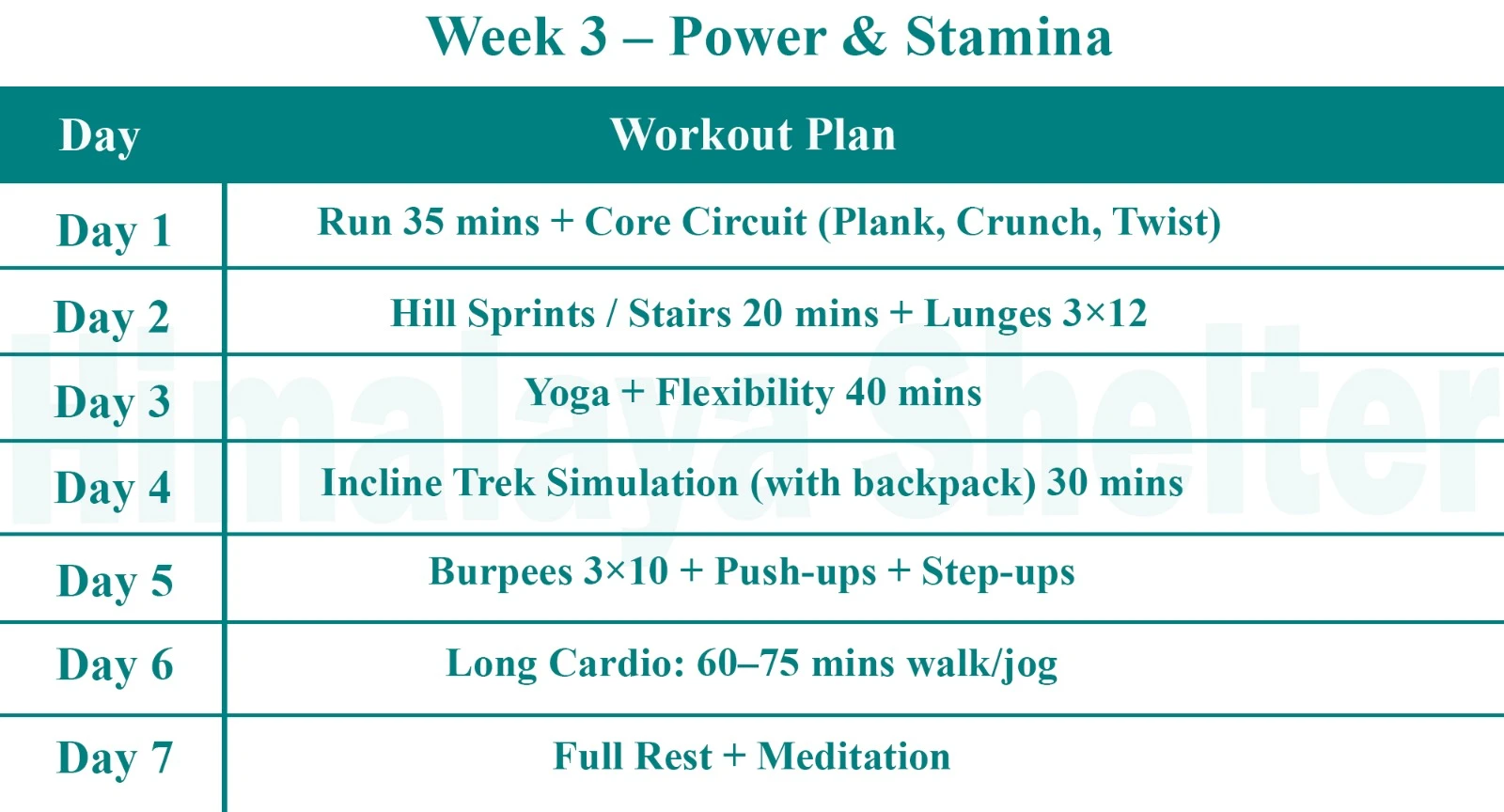
Power & Stamina
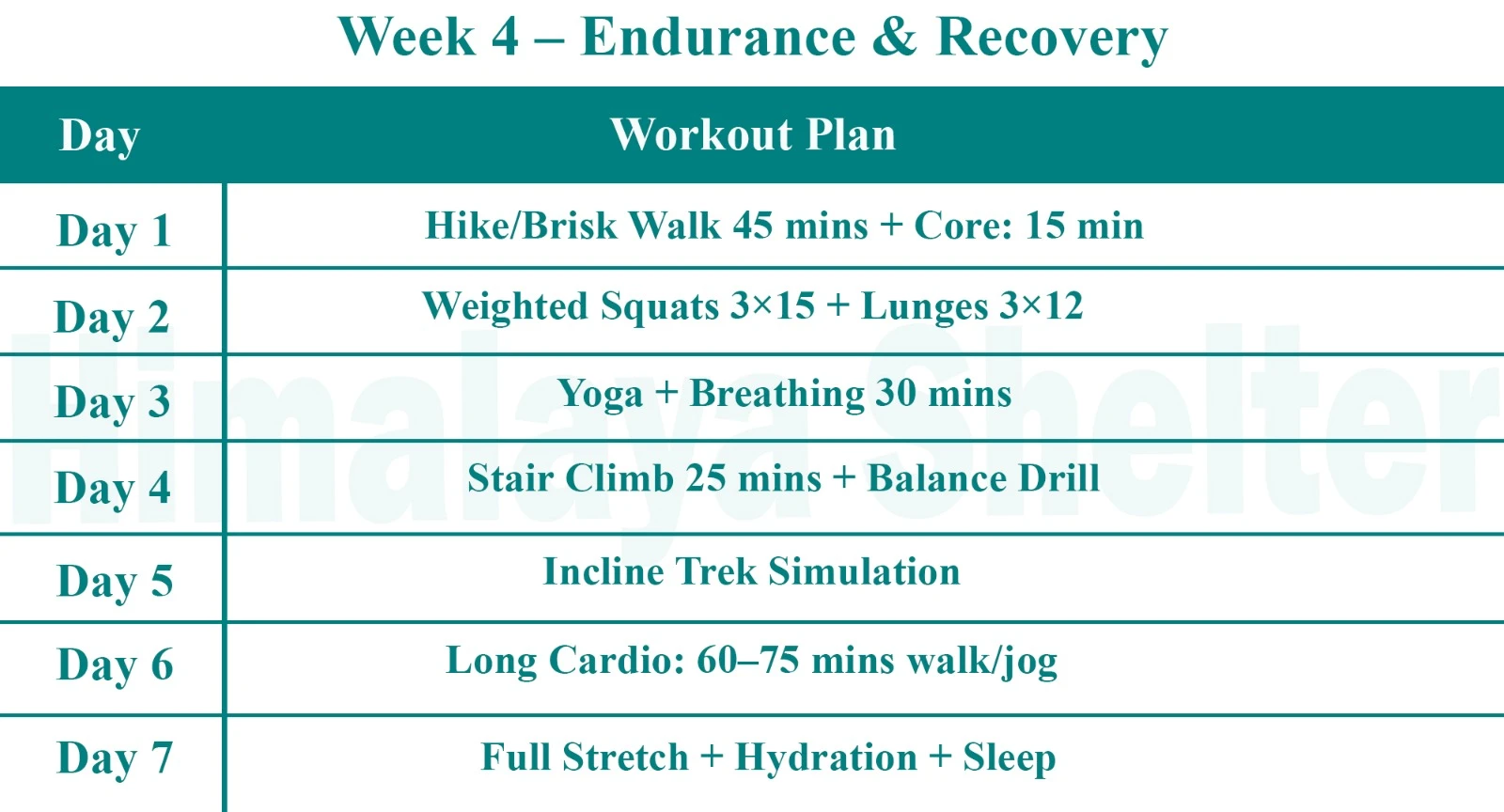
Endurance & Recovery
Day 1: Drive from Dehradun to Clouds End Mussoorie
Trek from Forest Check Post
- Distance: 35 kms drive
- Time taken: 2 hours
- Pick up point: Near Prince Chowk, Dehradun
- Trek Distance: 8 kms
- Time: 7 hours
- Altitude: 6805 ft to 7270 ft
As we pass through the city of Dehradun and drive further up, the breeze is cooler. As you go up you can see the entire city of Dehradun. A couple of hours drive and we reach the starting point of the trek which is Clouds End.
We start walking from the forest check post to the Benog Wildlife Sanctuary. In approximately 200 meters there is a diversion. There are two routes, one which goes towards the left meets a bridge and the other route to the right goes towards Benong Tibba. We take the route to the left, cross the bridge and another 50 meters walk leads us to a lovely clearing in the middle of the forest.
We take a steep climb and then the ascent becomes gradual. We continue on the same trail and in a few meters, we see a construction which is the summit where there is a small temple of Jwala Devi who is an avatar of the goddess Durga.
On a clear day one can see a 180-degree view of the Yamuna Valley and peaks of Nag tibba and the Garhwal valley. We spend some time here and soak in the views.
We then trek towards Benong Tibba basecamp and camp for the night.
Day 2: Benong Tibba Base Camp to Dehradun
- Distance: 36 kms drive
- Time taken: 2 hours
- Time: 2 hours
- Altitude: 7270 ft to 5150 ft
Today we walk towards the sanctuary gate and get ready to leave for Dehradun. The forests make it a walk to enjoy.
Inclusions
- Stay is included on Day 1 (Benog Tibba Base). You will be camping in tents at the base camp in Benog.
- All meals from lunch at Benog on Day 1 to lunch at Benog on Day 2 are included. We provide simple, nutritious vegetarian food on all days of the trek.
- Certified Trek Leader, Cook and Support Staff
- Transport to and from the Base Camp Cost of travel to Benog Tibba base and back to Dehradun is included in the trek fee.
- Forest Permits
- Camping Equipment including tents, kitchen & dining tents, toilet tents etc
- Gaiters, Microspikes, when needed
- Medical Kit
Exclusions
- Food during transit Any food you have during your travel to and from the base camp is in your own expense.
- Any Add Ons apart from the inclusions above
Mussoorie Wildlife Sanctuary in Benog is the location of the quick day hike known as the Benog Tibba Trek. Home to the almost extinct Mountain Quail the sanctuary was created in 1993. The Cloud End Forest Resort is where the hike begins. You are in the wilderness from the beginning.
Reaching the summit can take roughly 4-6 hours and the trek is roughly 9-10 kilometers long. Beautiful views of the Himalayan peaks can be seen from the trail which winds through thick forests. Arrive at Benog Tibba summit which is approximately 2225 meters (7300 feet) above sea level.
The endangered Ghoral mountain goat is found on the northern face of Benog Tibba. Ascending through the forest provides breathtaking panoramic views and makes it denser. There are enough challenges on the trails that cross with difficulty levels ranging from easy to moderate.
Cloud End Forest Resort situated in the Mussoorie Wildlife Sanctuary to the west of Mussoorie is the starting point for the Benog Tibba trek.
Yes, forest entry permission is required at the check post.
Yes, children above 6 with good stamina can join.
Yes, but inform locals or stay with groups.
Patchy or no signal near the summit.
Jwala Devi temple, Himalayan views, wildlife encounters, dense forest and peaceful atmosphere.
Read More on The Benog Hill Trek
Photo Gallery

Treks by Categories
Treks By Month

Treks By Experience

